Frogs are naturally suave animals. Among them, tree frogs are clever and it is difficult to see in common areas of our surroundings. You might find other frogs around your house corner or other apparent places but tree frogs used to hide themselves behind leaves or other identical places.
Moreover, some tree frogs use camouflage in the trees. These biological behaviors differentiate tree frogs from other ones. Here I want to introduce you with specific regional tree frogs and I have found Missouri to be the perfect fit for that.
In this article, I am going to discuss tree frogs in Missouri. And I will introduce you to different types of tree frogs that are found in Missouri. So read on until the end.
10 Beautiful Tree Frogs That Live In Missouri
At this time, I can describe 10 amazing tree frogs that you can see in missouri. All of them have distinct personalities, body shape, color, etc. This information will help you to identify these frogs. These are following:
1. Spring Peeper
Missouri is home to a large population of spring peepers. This type of tree frog has some distinctive traces that will help you to distinguish it from other tree frogs. Such as,
- The adults of this tree frog are small, the probable range will be 1.5 inches. That means, Spring Peepers are tiny frogs.
- This frog has a dark cross on its back, sometimes this might be seen as ‘X’. However, this sign is borne by both males and females of Spring Peeper frogs.
- Its brown or tan color makes it look amazing. You can distinguish the female frog here as a female spring peeper is lighter in color than a male one.
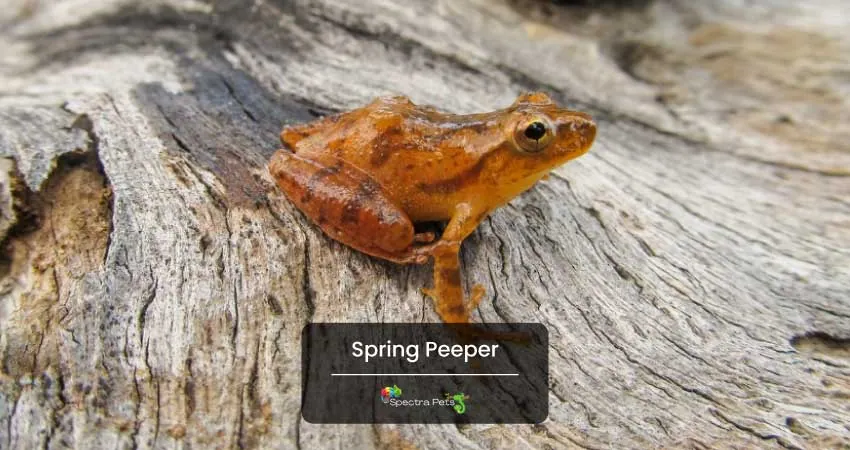
Like other tree frogs, Spring Peepers have big toe pads, which is a great advantage on their side so that they can climb up the trees easily. You will find them on the ground if you check the leaves which are on the ground.
Spring is their breeding season, they may be found in small waterbodies or ponds at that time of the year. They lay eggs there and from these places, tree frogs start their journey. The first stage is about three months, which is commonly called the tadpole stage. Then, they leave the ponds and water bodies.
“Spring Peeper” name comes from their behavior in the early spring. They used to sound like ‘peep’ at that time. You might have heard it at the farm of the little ducks. For this spring chorus, they are named as “Spring Peepers”. So, you can easily identify them in the forest by their spring chorus.
2. Blanchard’s Cricket-Frogs
Like Spring Peepers, another amazing tree frog is Blanchard’s Cricket-Frog. Sometimes, I wonder if each frog has unique characteristics that set it apart from the rest. That is the point that makes Blanchard’s Cricket-Frogs known to you. So let’s see the standards:
- An adult Blan-Cricket frog is generally 0.6″-1.5″ long. This frog is also small as a Spring Peeper tree frog.
- Blan-cricket frogs are of warty skin. These tree frogs are more diverse in colors. You might find them gray, olive green, tan or brown. It’s dark bindings, which are on its legs, will grab your attention.
- They have amazing eyes with triangular dark marks. A different kind of dimension around its body!
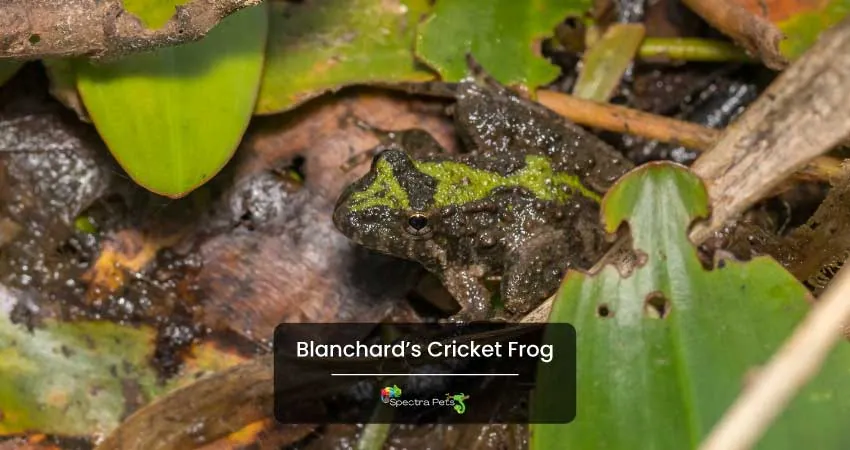
The biological behaviors are different from Spring Peepers, as Blan-cricket frogs usually live near or in permanent water bodies in Missouri. That indicates that these will live streams, slow-moving rivers, marshes, ponds, lakes, bogs, and so on. Point to be noted that Blan-cricket frogs are also found in temporary water bodies which are near to permanent water bodies. Like drainage ditches, flooded fields, etc.
Don’t be confused with Blan-cricket frogs’ preferred living places. Though they are from the tree frog family, they spend a long time in the water bodies and grounds. The lifespan of a Blan-cricket frog is approximately one year. Recently, they are facing chemical contamination, habitat loss, and other problems. These are driving this species to decline. Therefore, these things need to be taken into account.
3. Gray Tree-Frog
Gray tree frogs are among the most camouflage frogs that are not usually seen. But amazingly these species are found in Missouri in large numbers. Gray tree frogs have some unique characteristics that place them above other species of tree frogs. So let’s see,
- A Gray tree frog is longer than the former two, which is approximately two inches in length.
- It is easy for gray tree frogs to blend in with trees. They have different colors such as brown, green and mottled gray. Basically, mottled gray exceeds other colors, so it is named “Gray tree-frog”. You will see a whitish spot under its eyes.
- Bright orange, short snouts, and bumpy skin on its legs, that means undersides of Gray tree-frog’s legs.
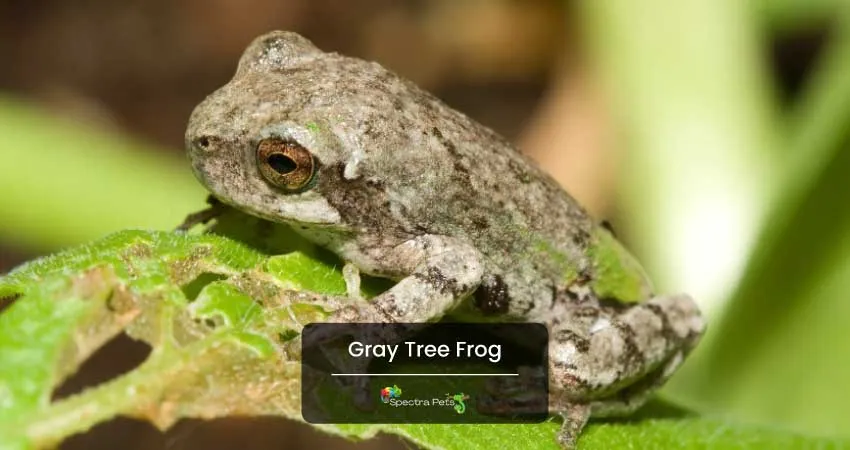
I have mentioned before that this tree frog is among the most camouflage frogs which gradually changes its color and eventually reaches a certain level when it will be hard for you to distinguish this tiny guy from the tree where this frog is sitting.
Until I learned about the Gray tree frog, I thought that Chameleons might be the only species that can change their colors according to the place where it is, but amazingly it is also the case with Gray tree frogs.
As a ubiquitous species, you will find this Gray army throughout Missouri. From swamps to forests to backyards, these are everywhere. Without breeding season, they pass their time in the treetops. They prefer water features of gardens, swamps, woodland ponds, and other places to lay eggs.
4. Bird-voiced Frogs
Among the different types of tree frogs, bird-voiced frogs are very attractive and charming. This frog is distinguished from other tree frogs by its excellent appearance. You should also remember that this frog is, in many ways, similar to big Gray tree frogs. Don’t be confused about both of them. Let’s see some unique characteristics of Bird-voiced Frogs:
- These tree frogs are approximately 2″ long and the Bird-voiced frog is longer than the former three frogs.
- These frogs are generally brown or pale grey colored. And, you also see the pale green shades in their body.
- On the Bird-voiced frog’s back, you will see a dark cross-shape. And it has darker limbs.
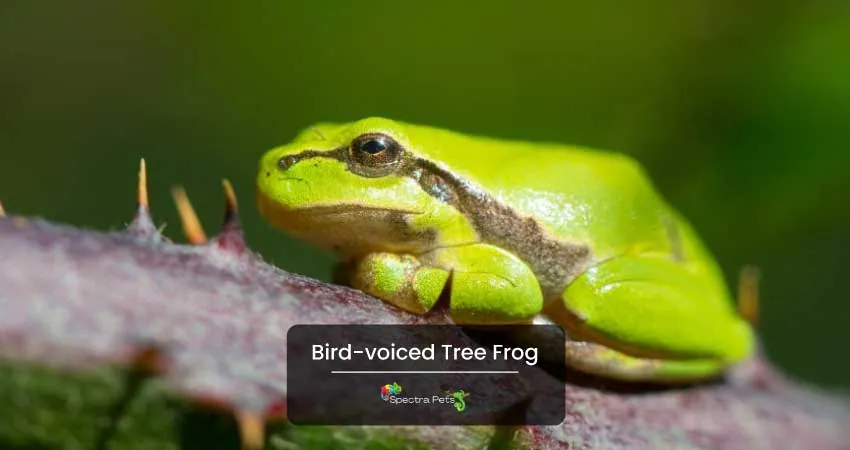
Bird-voiced frogs are usually found in wetlands, marshes, swampy forests, and other places in Missouri. These frogs are known as nocturnal species, which spend most of their time in the trees. During breeding seasons, they leave the trees and lay eggs in shallow pools. Within one month, tadpoles reach adulthood and disperse into their home.
As Spring Peepers, these species have a unique sound by which you can easily identify them. Bird-voiced frogs are nocturnal frogs so you will listen to their sound at night like “wit-wit”. Sometimes male Bird-voiced frogs sound in the daytime.
5. American Green Frogs
American Green Frogs are among the most beautiful and captivating animals I have ever seen. I imagine a frog like an American Green frog when one utters the words “tree frog”. It’s Because this frog is quite greenish and represents the color of trees. This has happened in my case. So, let’s see what makes a green frog different from other frogs:
- American Green Frog has smooth skin and this frog is one of the longest frogs out of here. Which can become approximately 2.5″ long.
- This frog is lime green, sometimes yellowish green, with white or pale yellow undersides.
- Down its sides, you will see white stripes and black borders.
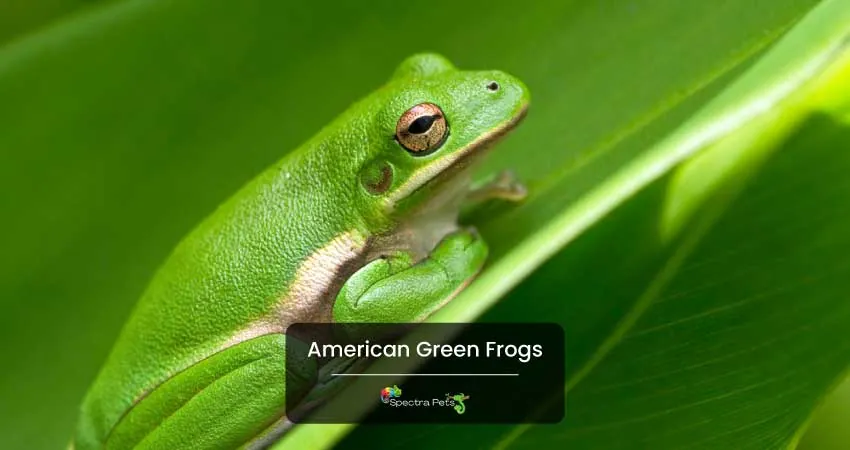
The shape, size, and color of the American Green Frogs testify that they are not the species of common range, they used to spend most of their time in the high places of trees.
Like other frogs, Green frogs come on the ground in their breeding season. They lay eggs in marshes, lakes, or ponds. Green frogs prefer water bodies with huge vegetation. It is claimed that, based on temperature and light, Green Frogs change their colors.
For its size and attractive appearance, people generally keep Green tree frogs as a pet. But you might not feel good rearing this pet as it is nocturnal. But this species is counted as one of the amazing tree frogs.
6. Cope’s Gray Frog
Cope’s Gray tree-frogs are usually found in Missouri and they are of the ‘tree frogs’ family. Every species of tree frog has unique characteristics so I add Cope’s Gray Frog here, but it does not completely resemble Gray tree-frog. Though both frogs have similarities, some unique features make them different. So let’s see its characteristics:
- A cope’s gray frog is approximately 2″ long.
- Cope’s Gray Frogs have different colors such as brown, green and mottled gray. Mostly, mottled gray exceeds other colors and a whitish spot appears under its eyes. On cope’s frog’s leg, you will see bumpy skin and attract short snouts.
- These frogs spend their life in woodland except for the time of breeding and go to the nearest ponds.
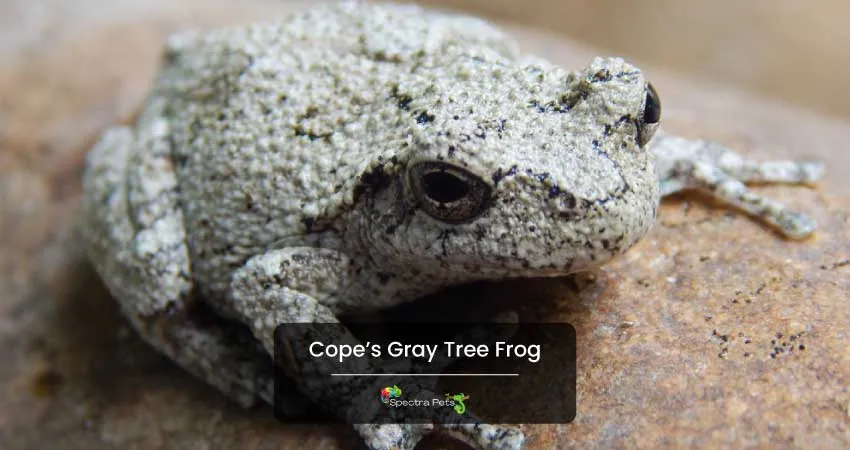
I think the differences between these two spaces will help you to identify them easily. Missouri Department of Conservation has analyzed that Cop’s Gray frogs are slightly smaller than eastern ones i.e. Gray tree frogs. A report has also shown that Cope’s ones are greener than Gray treefrogs.
The best way to distinguish these two frogs is their sounds. You will perceive that the eastern frog’s call is like a bird’s trill. But the call of a Cope’s Gray frog is like a buzzing trill. Scientists have also found differences in their chromosomes that you may learn from the webpage of the Missouri Department of Conservation.
7. Upland Chorus Tree Frogs
The Upland chorus tree frog is another species of tree frog’s family that used to live in Missouri. And this is a nice tree frog which is usually distinguished by its unique characteristics. All over Missouri, you can find this tree frog. So let’s see the main standards of it:
- Upland Chorus Tree Frogs are approximately 1.5 inches long.
- An upland chorus frog has different colors, these are reddish-brown or grey-brown and simply gray. You will see dark blotching on their skin.
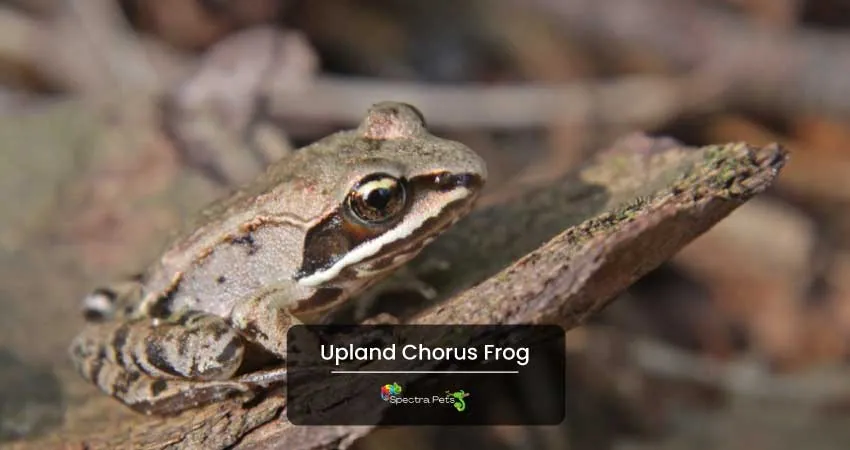
Upland Chorus Tree Frogs live in roadside ditches, flooded fields, and neighborhood ponds. They prefer a vegetated, moist habitat that is near the water. But they don’t spend a little in water. In the breeding season, you will find them in these places and can hear their chorus.
Throughout Missouri, you will find this species. The call of the Upland chorus tree frog is well known, you will trace it, it is like a plastic comb’s teeth when you will run your fingers through it.
8. Western Chorus Frog
Western Chorus frogs are common and known frogs in Missouri, you will find them eastern and also the Midwest United States. This frog is also a chorus frog. You can identify it by some characteristics, these are as follows:
- Western chorus frogs are one of the smallest frogs in Missouri and also throughout the country. The adult of it will be approximately 1.6 inches long. And the male of Western chorus is little compared with the female one.
- It has different colors such as brown, olive, reddish, greenish-grey with smooth skin.
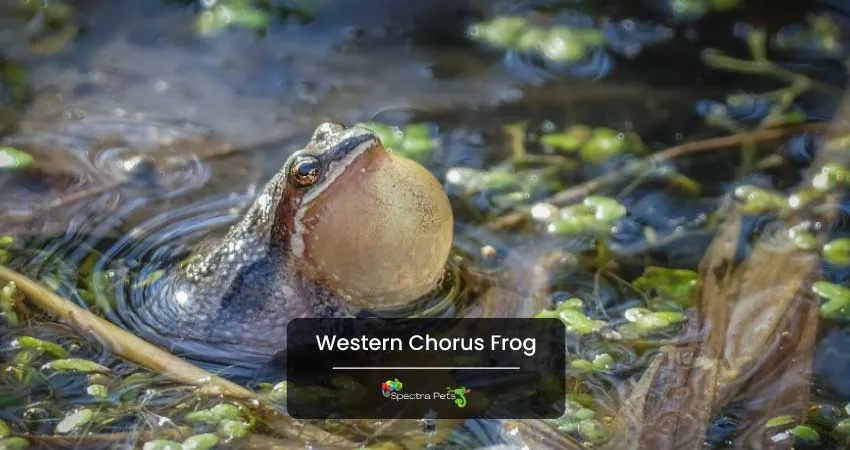
Western Chorus frogs are excellent in the time of breeding, the males attract their mates by different calls. In hot temperatures, when the temperature is high, you will hear the call of Western Chorus frogs very often.
These frogs live in different places, especially, grossy pools, meadows, river swamps, marshes and other places in prairies and mountains.
9. Illinois Chorus Frogs
The Illinois Chorus Frog is a beautiful member of the Tree Frog family. They live in a limited area of Missouri, especially in central Illinois and southeastern Missouri. Illinois Chorus Frogs have some unique characteristics, these are as follows:
- Illinois Chorus Frogs are little like Western Chorus. They are 1.5 inches long.
- You will see that the adult Illinois Chorus Frogs are tan-gray though you will see that they are green as well as there are dark spots on their skin. And you can also identify this frog by a triangle or diamond shaped between the two sides of their eye.
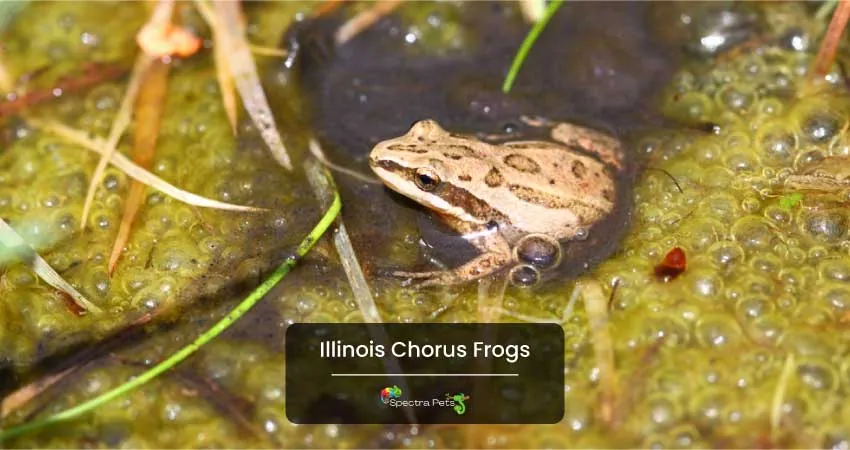
Illinois Chorus Frogs live on the side of the Illinois River and a major tributary of Missouri. These frogs are usually found in the ponds of meltwater and they stay there until mid-May. Then they found their place under the frost, hibernation.
They are distinguished by their call in their breeding season. You can hear their chorus from a distant place, approximately over one kilometer. Though they are facing threat now, as laser land-levelling is used for wetland where rice is grown. So they usually leave these places.
10. Boreal Chorus Frogs
Boreal Chorus Frogs are well known in Missouri, as they are statewide in Missouri. These frogs are called the subspecies of formerly discussed, western chorus. Here are some characteristics of Boreal Chorus Frogs:
- As they resemble in many cases with western chorus frogs, the adults of Boreal Chorus Frogs are about 1.5 inches long. Boreal Chorus frogs might overlap western chorus in some cases.
- You will see that the Boreal Chorus has different colors in it such as olive, grey, tan, reddish and brown. Dark stripes are usually seen on the back of Boreal Chorus Frog.
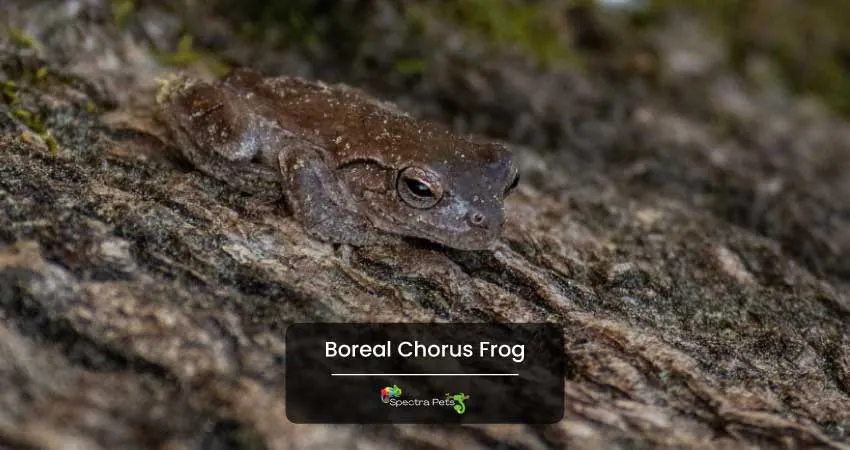
You will find Boreal Chorus Frogs in bodies of water besides forests or land. They call like “reeek” from vegetation or grasses. Remember that, don’t dilute Boreal Chorus Frogs with Western Chorus because Boreal have little legs.
Conclusion
Knowing about various Tree frogs in Missouri might help you to differentiate among them. In this writing, I have discussed about 10 tree frogs along with their biological behaviors in brief. Every species has its own methodology to survive on the earth. And they still survive on the earth after encountering unfavorable situations. And finally this methodology makes it different from other ones.
Tree Frogs Found in the Nearby States of Missouri:
